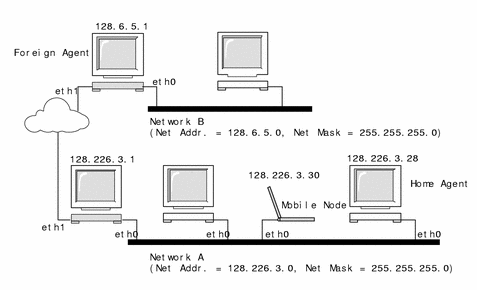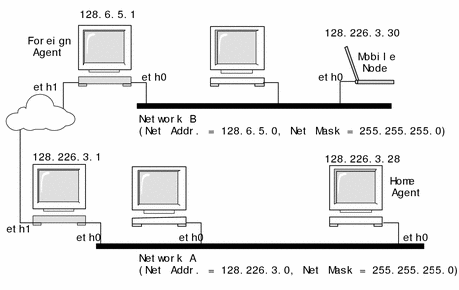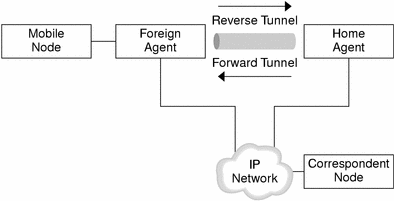How Mobile IP Works
Mobile IP enables routing of IP datagrams to mobile nodes. The mobile node's home address always identifies the mobile node, regardless of its current point of attachment to the Internet or an organization's network. When away from home, a care-of address associates the mobile node with its home address by providing information about the mobile node's current point of attachment to the Internet or an organization's network. Mobile IP uses a registration mechanism to register the care-of address with a home agent.
The home agent redirects datagrams from the home network to the care-of address by constructing a new IP header that contains the mobile node's care-of address as the destination IP address. This new header then encapsulates the original IP datagram, causing the mobile node's home address to have no effect on the encapsulated datagram's routing until it arrives at the care-of address. This type of encapsulation is also called tunneling. After arriving at the care-of address, each datagram is de-encapsulated and then delivered to the mobile node.
The following illustration shows a mobile node residing on its home network, Network A, before the mobile node moves to a foreign network, Network B. Both networks support Mobile IP. The mobile node is always associated with its home network by its permanent IP address, 128.226.3.30. Though Network A has a home agent, datagrams destined for the mobile node are delivered through the normal IP process.
Figure 1–2 Mobile Node Residing on Home Network

The following illustration shows the mobile node moving to a foreign network, Network B. Datagrams destined for the mobile node are intercepted by the home agent on the home network, Network A, encapsulated, and sent to the foreign agent on Network B. Upon receiving the encapsulated datagram, the foreign agent strips off the outer header and delivers the datagram to the mobile node visiting Network B.
Figure 1–3 Mobile Node Moving to a Foreign Network

The care-of address might belong to a foreign agent, or might be acquired by the mobile node through Dynamic Host Configuration Protocol (DHCP) or Point-to-Point Protocol (PPP). In the latter case, a mobile node is said to have a co-located care-of address.
The mobile node uses a special registration process to keep its home agent informed about its current location. Whenever a mobile node moves from its home network to a foreign network, or from one foreign network to another, it chooses a foreign agent on the new network and uses it to forward a registration message to its home agent.
Mobility agents (home agents and foreign agents) advertise their presence using agent advertisement messages. A mobile node can optionally solicit an agent advertisement message from any locally attached mobility agents through an agent solicitation message. A mobile node receives these agent advertisements and determines whether they are on its home network or a foreign network.
When the mobile node detects that it is located on its home network, it operates without mobility services. If returning to its home network from being registered elsewhere, the mobile node deregisters with its home agent.
Mobile IP With Reverse Tunneling
The previous description of Mobile IP assumes that the routing within the Internet is independent of the data packet's source address. However, intermediate routers might check for a topologically correct source address. If an intermediate router does check, you should set up a reverse tunnel. By setting up a reverse tunnel from the mobile node's care-of address to the home agent, you ensure a topologically correct source address for the IP data packet. A mobile node can request a reverse tunnel between its foreign agent and its home agent when the mobile node registers. A reverse tunnel is a tunnel that starts at the mobile node's care-of address and terminates at the home agent. The following illustration shows the Mobile IP topology that uses a reverse tunnel.
Figure 1–4 Mobile IP With a Reverse Tunnel

Limited Private Addresses Support
Mobile nodes that have private addresses which are not globally routable through the Internet require reverse tunnels. Solaris Mobile IP supports only privately addressed mobile nodes. See Overview of the Solaris Mobile IP Implementation for the functions that Solaris Mobile IP does not support.
Enterprises employ private addresses when external connectivity is not required. Private addresses are not routable through the Internet. When a mobile node has a private address, the mobile node can only communicate with a correspondent node through a reverse tunnel. The privately addressed correspondent node must belong to the same home agent's administrative domain. The following illustration shows a network topology with two privately addressed mobile nodes that use the same care-of address when registered to the same foreign agent.
Figure 1–5 Privately Addressed Mobile Nodes Residing on the Same Foreign Network

Because both privately addressed mobile nodes belong to the same administrative domain, the home agent knows how to route data packets between the two mobile nodes. Also, the foreign agent's care-of address and the home agent's IP address must be globally routable addresses.
It is possible to have two privately addressed mobile nodes with the same IP address residing on the same foreign network. This situation is only possible when each mobile node has a different home agent. Also, this situation is only possible when each mobile node is on different advertising subnets of a single foreign agent. The following illustration shows a network topology that depicts this case.
Figure 1–6 Privately Addressed Mobile Nodes Residing on Different Foreign Networks

Because both privately addressed mobile nodes have the same IP address and because these mobile nodes belong to different home agent domains, the two nodes cannot communicate with each other. However, each node can communicate with nodes in its corresponding home agent's administrative domain through the reverse tunnel. For example, Mobile Node 2 can communicate with Correspondent Node 2 in the previous illustration.
- © 2010, Oracle Corporation and/or its affiliates
